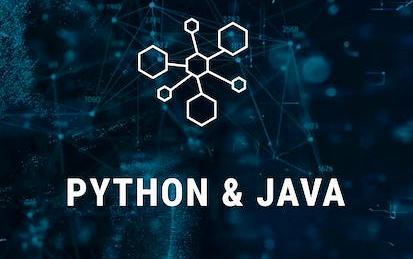

دوراتنا

Advanced Data Modeling
Develop a working knowledge and familiarity with advanced database concepts such as usage, modeling, automation, storage, optimization and administration. To take this course, you must have completed the previous Database courses. You must also be eager to continue your journey with coding. The Professional Certificates create opportunities so that anyone regardless of education, background or experience can learn high-quality skills to land a high-growth career—no degree or experience required to get started.
-
Course by

-
 Self Paced
Self Paced
-
 18 ساعات
18 ساعات
-
 الإنجليزية
الإنجليزية

Test your Build in the Debugger with Eclipse
By the end of this project, you will be able to use the Eclipse Debugger to create breakpoints, view the values of variables, add step filters, create exception breakpoints, create condition breakpoints and use tracepoints. This project uses Java with the Eclipse IDE.
-
Course by

-
 3 ساعات
3 ساعات
-
 الإنجليزية
الإنجليزية

How to Use ChatGPT in Tech/Coding/Data
Are you tired of spending hours writing and debugging code? Do you want to streamline your programming workflow and enhance your productivity? Look no further than How to Use ChatGPT in Tech/Coding/Data! In this course, you will learn how to harness the power of ChatGPT to revolutionize your coding process. From ideation to testing and debugging, ChatGPT can generate code programmatically, saving you valuable time and energy.
-
Course by

-
 Self Paced
Self Paced
-
 1
1
-
 الإنجليزية
الإنجليزية

Testing and Debugging Python
If you have seen any of the news lately, it is not hard to imagine why software bugs cost the economy billions of dollars per year as well as costing lives. The ability to test your code (and other’s code) is probably one of the most important skills to know as a developer. Knowing how to track down and fix bugs is also critical.
Testing can mean adding print statements to output data at certain points in a program to visually check it. Testing can also involve developing separate programs to test the functionality of the code itself.
-
Course by

-
 Self Paced
Self Paced
-
 2 ساعات
2 ساعات
-
 الإنجليزية
الإنجليزية

Securing and Integrating Components of your Application 日本語版
このコースでは、アプリケーション デベロッパー向けに、Google Cloud のマネージド サービスをシームレスに統合するクラウドネイティブ アプリケーションを設計、開発する方法を説明します。講義、デモ、ハンズオンラボを通して、メッセージング、イベント駆動型処理、API ゲートウェイを使ったセキュリティ性の高いアプリケーションの設計、フェデレーション ID 管理の実装、アプリケーション コンポーネントの統合方法を学習します。 各ラボのいずれかのバージョンを完了する必要があります。各ラボは Node.js で利用できるほか、ほとんどの場合、Python または Java でも提供されます。お好みの言語でラボを完了できます。 本コースは、「Developing Applications with Google Cloud」シリーズの 2 つ目のコースですこのコースを修了したら、「App Deployment, Debugging, and Performance」コースに登録してください。
-
Course by

-
 Self Paced
Self Paced
-
 ياباني
ياباني

Introduction to .NET Core
The Introduction to .NET Core course is designed to equip learners with the necessary skills to build web applications using the powerful .NET Core framework. The course is organized into three distinct modules. The first module lays the foundation of .NET Core, discussing its history, features, differences from other technologies, and how to set up the development environment.
-
Course by

-
 Self Paced
Self Paced
-
 13 ساعات
13 ساعات
-
 الإنجليزية
الإنجليزية

Computing in Python I: Fundamentals and Procedural Programming
Learn the fundamentals of computing in Python, including variables, operators, and writing and debugging your own programs.
-
Course by

-
 الإنجليزية
الإنجليزية

Java Programming and Software Engineering Fundamentals
Take your first step towards a career in software development with this introduction to Java—one of the most in-demand programming languages and the foundation of the Android operating system. Designed for beginners, this Specialization will teach you core programming concepts and equip you to write programs to solve complex problems. In addition, you will gain the foundational skills a software engineer needs to solve real-world problems, from designing algorithms to testing and debugging your programs.
-
Course by

-
 Self Paced
Self Paced
-
 الإنجليزية
الإنجليزية

App Deployment, Debugging, and Performance en Français
Dans ce cours, les développeurs d'applications apprennent à concevoir et à développer des applications cloud natives qui s'intègrent parfaitement aux composants de l'écosystème Google Cloud. À travers un ensemble de présentations, de démonstrations et d'ateliers pratiques, les participants découvrent comment créer des déploiements reproductibles en traitant l'infrastructure comme du code, en choisissant l'environnement d'exécution approprié pour une application et en surveillant les performances applicatives. Il est obligatoire de terminer une version de chaque atelier.
-
Course by

-
 Self Paced
Self Paced
-
 الإنجليزية
الإنجليزية

Mathematics for Machine Learning and Data Science
Newly updated for 2024! Mathematics for Machine Learning and Data Science is a foundational online program created by DeepLearning.AI and taught by Luis Serrano. In machine learning, you apply math concepts through programming. And so, in this specialization, you’ll apply the math concepts you learn using Python programming in hands-on lab exercises.
-
Course by

-
 Self Paced
Self Paced
-
 الإنجليزية
الإنجليزية

Meta React Native
If you want to learn how to create apps for Android and iOS devices, this course is right for you. This program is taught by industry-recognized experts at Meta. Cross-platform mobile developers build and write code for apps that are hosted on mobile devices powered by multiple operating systems. They do everything from creating the app to debugging it after deployment.
-
Course by

-
 Self Paced
Self Paced
-
 الإنجليزية
الإنجليزية

Developing Industrial Internet of Things
The courses in this specialization can also be taken for academic credit as ECEA 5385-5387, part of CU Boulder’s Master of Science in Electrical Engineering degree. Enroll here. In this specialization, you will engage the vast array of technologies that can be used to build an industrial internet of things deployment.
-
Course by

-
 Self Paced
Self Paced
-
 الإنجليزية
الإنجليزية

FPGA Design for Embedded Systems
The objective of this course is to acquire proficiency with Field Programmable Gate Arrays (FPGA)s for the purpose of creating prototypes or products for a variety of applications. Although FPGA design can be a complex topic, we will introduce it so that, with a little bit of effort, the basic concepts will be easily learned, while also providing a challenge for the more experienced designer. We will explore complexities, capabilities and trends of Field Programmable Gate Arrays (FPGA) and Complex Programmable Logic Devices (CPLD).
-
Course by

-
 Self Paced
Self Paced
-
 الإنجليزية
الإنجليزية

Learn to Teach Java
Learn to teach introductory Java -- with a focus on the new Advanced Placement Computer Science A curriculum. Preview the CS Awesome curriculum with overview videos to help you prepare for class efficiently. Learn teaching tips and access supporting materials from an expert in CS education with 15+ years experience including advice on teaching debugging, code tracing (for answering multiple choice questions) and problem solving patterns. Complete activities specifically designed for teachers and create materials you can use in your classroom.
-
Course by

-
 Self Paced
Self Paced
-
 الإنجليزية
الإنجليزية

JavaScript Debugging Tips for Beginners
By the end of this project you will have used several techniques for debugging JavaScript code. Locating and fixing errors in JavaScript can be very challenging since JavaScript doesn’t necessarily display error messages. To help with the debugging process, you will practice with a few simple tools, like desk-checking and JavaScript alerts. And, you will be introduced to some of the debugging tools built into the Chrome browser.
Note: This course works best for learners who are based in the North America region. We’re currently working on providing the same experience in other regions.
-
Course by

-
 Self Paced
Self Paced
-
 3 ساعات
3 ساعات
-
 الإنجليزية
الإنجليزية

Introduction to Programming with Python and Java
This Specialization starts out by teaching basic concepts in Python and ramps up to more complex subjects such as object-oriented programming and data structures in Java. By the time learners complete this series of four courses, they will be able to write fully-functional programs in both Python and Java, two of the most well-known and frequently used programming languages in the world today. Introduction to Programming with Python and Java is for students and professionals who have minimal or no prior programming exposure.
-
Course by

-
 Self Paced
Self Paced
-
 الإنجليزية
الإنجليزية

Automate Cybersecurity Tasks with Python
This is the seventh course in the Google Cybersecurity Certificate. These courses will equip you with the skills you need to apply for an entry-level cybersecurity job. You’ll build on your understanding of the topics that were introduced in the sixth Google Cybersecurity Certificate course. In this course, you will be introduced to the Python programming language and apply it in a cybersecurity setting to automate tasks. You'll start by focusing on foundational Python programming concepts, including data types, variables, conditional statements, and iterative statements.
-
Course by

-
 Self Paced
Self Paced
-
 30 ساعات
30 ساعات
-
 الإنجليزية
الإنجليزية

Learn SQL Basics for Data Science
This Specialization is intended for a learner with no previous coding experience seeking to develop SQL query fluency. Through three progressively more difficult SQL projects with data science applications, you will cover topics such as SQL basics, SQL analysis, problem- solving strategies, debugging, improving data quality, and more.
-
Course by

-
 Self Paced
Self Paced
-
 الإنجليزية
الإنجليزية
Attitude Control with Momentum Exchange Devices
This course is part 1 of the specialization Advanced Spacecraft Dynamics and Control. It is a direct continuation of the Coursera specialization Spacecraft Dynamics and Control. This first course focuses on nonlinear attitude feedback control using a range of angular momentum devices. The course provides a comprehensive review of prerequisite material. Next it develops equations of motion of a spacecraft with momentum exchange devices such as reaction wheels (RWs), control momentum gyroscopes (CMGs) and variable speed control moment gyroscopes (VSCMGs).
-
Course by

-
 Self Paced
Self Paced
-
 45 ساعات
45 ساعات
-
 الإنجليزية
الإنجليزية

R Programming
In this course you will learn how to program in R and how to use R for effective data analysis. You will learn how to install and configure software necessary for a statistical programming environment and describe generic programming language concepts as they are implemented in a high-level statistical language. The course covers practical issues in statistical computing which includes programming in R, reading data into R, accessing R packages, writing R functions, debugging, profiling R code, and organizing and commenting R code.
-
Course by

-
 Self Paced
Self Paced
-
 57 ساعات
57 ساعات
-
 الإنجليزية
الإنجليزية

Troubleshooting and Debugging Techniques
In this course, we'll give you the tools to quickly identify and solve real-world problems that you might come across in your IT role. We'll look at a bunch of different strategies and approaches for tackling the most common pitfalls of your code and IT infrastructure. You'll learn strategies for approaching almost any technical problem and then see how those apply to solving different real-world scenarios. We picked examples that include general system issues, issues with software that someone else wrote, and issues with programs that we wrote.
-
Course by

-
 Self Paced
Self Paced
-
 16 ساعات
16 ساعات
-
 الإنجليزية
الإنجليزية

HTML and CSS in depth
In this course, you’ll use software development tools like HTML to build attractive web pages that work well—and you’ll use structured semantic data to control how websites appear to the end user. You will then dive deeper into CSS by applying increasingly specific styling to various elements. You’ll learn to use Bootstrap’s grid system to create layouts and work with components and themes.
-
Course by

-
 Self Paced
Self Paced
-
 29 ساعات
29 ساعات
-
 الإنجليزية
الإنجليزية

App Deployment, Debugging, and Performance
In this course, application developers learn how to design and develop cloud-native applications that seamlessly integrate components from the Google Cloud ecosystem. Through a combination of presentations, demos, and hands-on labs, participants learn how to create repeatable deployments by treating infrastructure as code, choose the appropriate application execution environment for an application, and monitor application performance.
-
Course by

-
 Self Paced
Self Paced
-
 9 ساعات
9 ساعات
-
 الإنجليزية
الإنجليزية

Python Basics
This course introduces the basics of Python 3, including conditional execution and iteration as control structures, and strings and lists as data structures. You'll program an on-screen Turtle to draw pretty pictures. You'll also learn to draw reference diagrams as a way to reason about program executions, which will help to build up your debugging skills. The course has no prerequisites.
-
Course by

-
 Self Paced
Self Paced
-
 34 ساعات
34 ساعات
-
 الإنجليزية
الإنجليزية

Building Scalable Java Microservices with Spring Boot and Spring Cloud
"Microservices" describes a software design pattern in which an application is a collection of loosely coupled services. These services are fine-grained, and can be individually maintained and scaled. The microservices architecture is ideal for the public cloud, with its focus on elastic scaling with on-demand resources. In this course, you will learn how to build Java applications using Spring Boot and Spring Cloud on Google Cloud. You'll use Spring Cloud Config to manage your application's configuration. You'll send and receive messages with Pub/Sub and Spring Integration.
-
Course by

-
 Self Paced
Self Paced
-
 12 ساعات
12 ساعات
-
 الإنجليزية
الإنجليزية



